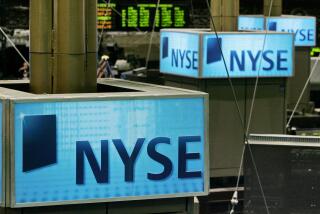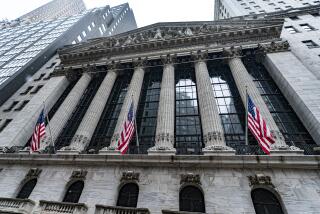At last, trickle-down from the profit boom
Nobody uses superlatives to describe the U.S. economic recovery.
But we’re running out of them to describe the continuing recovery in corporate earnings.
The companies in the blue-chip Standard & Poor’s 500 index racked up another quarter of stellar profit gains in the first three months of this year. Overall operating earnings of the S&P companies rose about 17% from a year earlier, the sixth consecutive double-digit increase.
Firms such as Intel Corp., Domino’s Pizza Inc. and Illinois Tool Works have little in common except for how they wowed Wall Street with their first-quarter results, despite having to shell out more for many raw materials.
The profit boom is a big reason why stock prices have held up this year despite a raft of troubling news, from Middle East unrest to Japan’s earthquake to Europe’s renewed government-debt crisis.
Remember the debate two years ago over what the economy’s rebound would look like on a chart, after the deep plunge of 2008 and early 2009? Optimists hoped for a V-shaped recovery, particularly for the devastated job market.
Instead, “profits are the one V-shaped thing we got,” said Heidi Shierholz, a labor market economist at the Economic Policy Institute in Washington.
The implicit promise was that hiring would eventually follow the turn in earnings. But only now are there signs of that promise being fulfilled. One clue was the jump in private-sector jobs in April, the biggest increase in five years.
What took so long? Though earnings provide the financial wherewithal for companies to hire, the S&P 500 firms’ glowing bottom-line results of the last 18 months haven’t been enough justification for many businesses to add staff. That’s because a large chunk of the profit gains have stemmed from the deep cost-cutting that companies undertook during the recession, including massive layoffs.
After such vicious downsizing, even a slight improvement in sales can fuel a spectacular leap in earnings. But to be confident about continued earnings growth, a business needs to be confident about sales growth. That has been the great nagging doubt about the U.S. recovery — that it would fizzle, and with it demand for goods and services.
“Companies weren’t sure how sustainable the recovery would be,” said Stephen Stanley, chief economist at Pierpont Securities in Stamford, Conn.
That also was a convenient excuse to put off hiring if executives were more confident than they let on.
Last year, however, revenue of the S&P 500 companies rose 6% from 2009. More important, that momentum accelerated in the first quarter of this year: With 90% of the S&P 500 results in, total sales of companies in the index appear to have risen about 10% from a year earlier, according to Howard Silverblatt, who crunches the numbers for S&P in New York.
If that percentage gain holds up, it would mark the first double-digit sales increase since the first quarter of 2006, Silverblatt said.
Sales growth can derive from a mix of higher demand, price hikes, acquisitions and, in the case of multinational firms, gains from currency translations when the dollar weakens. Investors focus on fundamental demand because that shows how a company’s basic business is faring. And Wall Street thinks it saw healthy fundamental demand in the first quarter in many industries.
Intel stunned investors with a 25% jump in first-quarter sales as corporate computer purchases far exceeded expectations, boosting orders for the company’s chips.
In reporting their latest quarterly results, more than a few chief executives also have been upbeat about future global demand.
“The economic recovery in the United States, Western Europe and other developed markets continues to gain solid footing,” Dow Chemical CEO Andrew Liveris said when the company reported a 32% surge in first-quarter profit on a 20% rise in sales.
Of course, even if the biggest companies decide to do some hiring, there’s no guarantee it will be in the U.S. — especially given that their best sales growth may be in emerging-market countries. And the conventional wisdom is that most jobs are created by small companies, many of which face far greater struggles in this economy than the titans.
Yet in a March survey by the Business Roundtable, an association of chief executives of major U.S. firms, 52% of the CEOs said they expected their domestic payrolls to rise in the following six months, up from 45% in the group’s December survey.
It seems unlikely that the hiring data this year just happen to coincide with the strong sales results of the S&P 500 companies.
The net gain in U.S. private-sector jobs averaged 253,000 a month from February through April, the largest total for any three-month stretch since early in 2006, though woefully short of what’s needed to make a significant dent in the 9% jobless rate.
“This is the first chunk of real momentum we’ve seen” in employment, Shierholz said. “The question is whether we’re going to hang on to even that.”
Some data in the last few weeks have suggested that the U.S. economy has softened. In particular, new claims for unemployment benefits have risen since March, though the Labor Department says the numbers have been skewed by special factors.
There are good reasons to fear that job growth could sputter again. High gasoline prices are sapping consumers’ spending power. The housing market remains abysmal. Credit-tightening moves in emerging-market countries threaten to slow their demand for American exports. And no one knows what will happen to U.S. long-term interest rates when the Federal Reserve ends its $600-billion Treasury-bond-buying program June 30.
There also is the basic question of how many businesses really need to add staff. Technology keeps eliminating jobs, and that isn’t going to stop. And some companies have ample room to boost current workers’ hours to meet higher demand, before needing to add more people to payroll.
Still, big companies aren’t in business to keep the status quo; their goal is to grow. And most growing companies, by definition, eventually need more people.
Department store chain Kohl’s Corp. plans to open a new online-sales distribution center in Maryland this summer and to hire 1,200 people over the next three years.
Intel expects to hire at least 800 highly skilled workers for a new manufacturing facility it’s building in Oregon.
One of the most encouraging trends in the labor market has been the turnaround in U.S. manufacturing jobs. That sector has added a net 141,000 jobs this year, 32,000 more than the total for all of last year.
Mere drops in a bucket in an economy with 13.7 million unemployed people? Yes. But it’s a start.
Don Rissmiller, chief economist at Strategas Research Partners in New York, believes that the recovery has reached a point where companies will feel the need to add talent before their competition does. That would create self-reinforcing job growth.
“It’s almost astounding that we got this far without adding workers,” he said.
What we need now is the return of the so-called virtuous cycle: More jobs mean more people earning income, which boosts demand for goods and services, which further lifts companies’ earnings, which gives them more confidence to pursue growth that leads to more jobs.
Though corporate America has reaped far more of the benefits of this recovery than labor has, we have a much greater chance of repeating the virtuous cycle if earnings are good than if they’re lousy.






